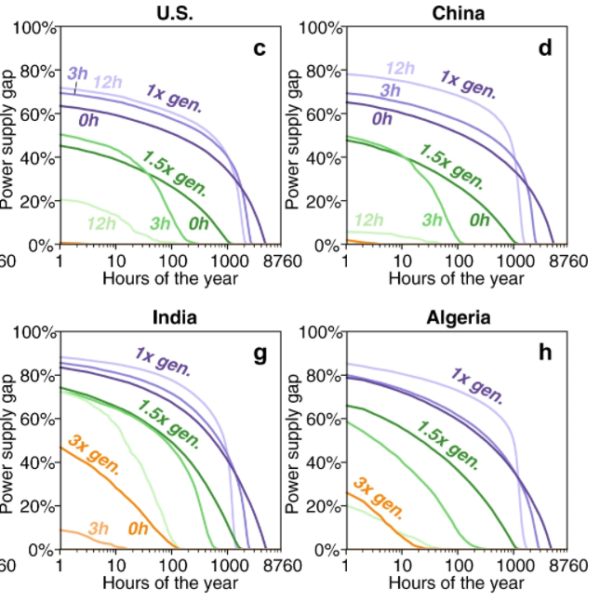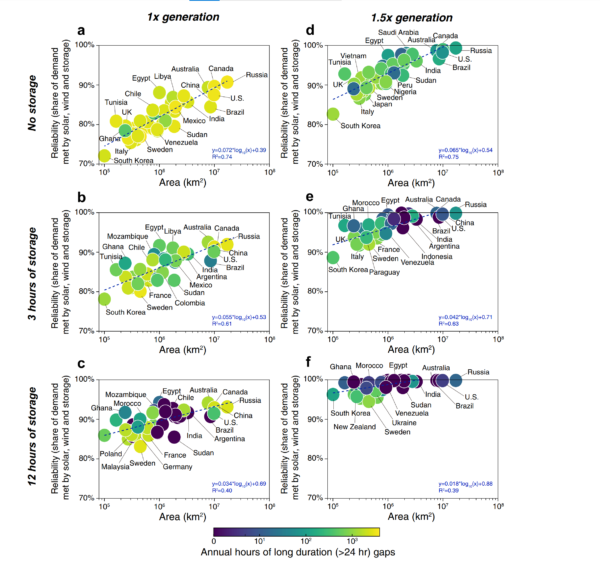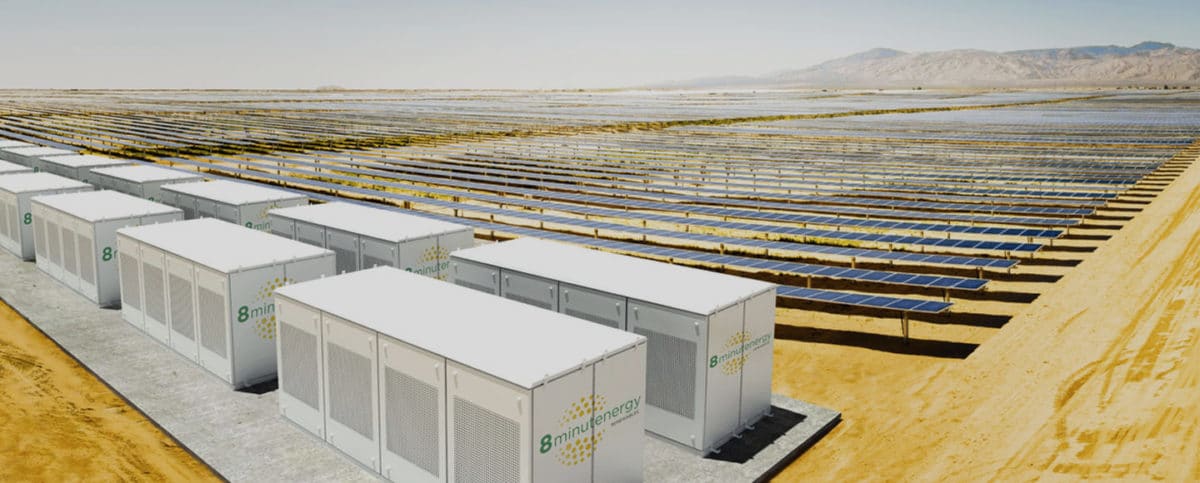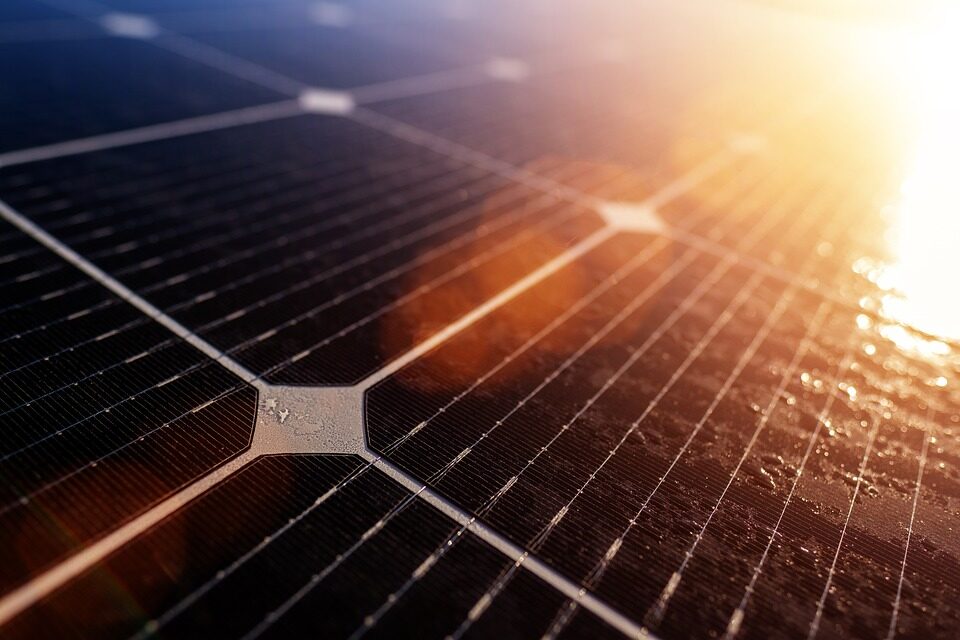Researchers recently published a paper in which they seek to understand how far we can go with wind and solar.
The research analyzes 39 years of hourly wind and solar generation data across 42 countries. An evaluation of “perfect” transmission without energy storage finds that the most reliable renewable electricity systems are wind-heavy and satisfy countries’ electricity demand in 72–91% of hours (or in 83–94% of hours by adding 12 hours of storage).
The research found, however, that even in systems which meet more than 90% of demand, “hundreds of hours of unmet demand” may occur each year.
The research quantified the power, energy, and utilization rates of additional energy storage and demand management, (curtailment), as well as the benefits of regional aggregation. The models evaluated three levels of excess generation (1x, 1.5x, and 3x) and storage (none, 3 hours, and 12 hours).
Notably, the researchers concluded that wind and solar generation resources that were sized at 1.5x along with three hours of energy storage would meet all but 200 hours of demand scattered throughout any given year.

Prior research by Caldeira suggested that the United States could reach a dependable power grid made up of 80% wind and solar power with approximately 12 hours of energy storage. This 80% model would require no additional power grid transmission resources.
The models found that countries with larger land areas can (obviously) build wind+solar power grid systems with greater reliability. For systems without integrated energy storage, the ability to meet energy demand increased by 7.2% for every factor of 10 increase in land area.
When three or even 12 hours of energy storage are added, patterns begin to emerge.

The top left of the above chart shows a standard volume of generation with no energy storage. It shows a clear linear increase in reliability associated with the country’s area. But, in cases where three or 12 hours of energy storage are added, generating capacity increases by 50%, and reliability increases dramatically.
In fact, when looking at the lower right box with 12 hours of batteries and 1.5x standard generation, the ability of wind and solar to meet electricity demand brings all of the nations analyzed in the study above 97%; several countries were modeled as meeting 100% of demand.
The research suggested a trade-off point exists for excess generation and energy storage as a 10% increase in excess annual generation is equivalent to 3.9 hours of storage.
The paper showed that even with energy storage, gaps in the schedule of heavy wind plus solar systems still find periods where dispatchable resources will be needed. And though it is easy to suggest fossil-based facilities as a solution to these down times, it will become economically challenging to do so, as the mined volume of those fuel sources — coal and gas — declines.
Additionally, technologies like hydrogen, vehicle batteries, nuclear, and hydro will be needed to fill in the weak spots. If we do figure out how to limit our political squabbling and build intra- and international transmission, we will achieve maximum renewable energy resource utilization.
Oversize?
If we do find that “oversizing” wind and solar deployment beyond currently defined standard system sizing is in fact the best way to size things, then the word “oversize” is a misnomer.
When these projects are generating electricity in amounts greater than the power grid’s demand, entrepreneurial spirits and asset owners no doubt will seek ways to make better use of these resources.
Generally, it would not make sense to place expensive hardware — such as hydrogen electrolyzers or bitcoin mining rigs — at renewable generation project sites to run “only” when the sites are overproducing.
It would make sense, however, to place energy-hungry industries near renewable generation, with the intention to run on both grid power and on summertime peak generation power which otherwise would have been curtailed. In this way, we can bring down average electricity prices for these facilities, and create a valuable resource out of necessary, seasonal excess.
This content is protected by copyright and may not be reused. If you want to cooperate with us and would like to reuse some of our content, please contact: editors@pv-magazine.com.








“Overgeneration” will naturally occur. The solar- and wind power industries will not just simply surrender their profits, and workers will not simply give up their jobs, once the big ramp-up is completed. They will fight for their survival just as fossil industries do right now. I foresee a future where clean energy is abundant at nominal cost.
Given the existing hydropower, biomass and geothermal, and the fact that we are presently on track to end fossil generation before most of the existing nuclear plants retire, I’d say we’re closer than that. I did an hourly analysis of wind in MISO, and found that 70% of MISO’s electricity could be produced with just 8% of the electricity being available for storage (produced at times when power was not needed directly).
In other words, if we want something to store we need to have even more than 70% wind in MISO. But the complementary nature of wind plus solar will make the need for storage even smaller.
To Mathias, I say that the world needs about $5 – 6 trillion in new wind and solar, the U.S. $1.3 trillion. By the time we finish this the original equipment will be due for upgrades, and there will be a pretty steady state rate of full employment.
The biggest missing piece to the public dialogue is what this means for developing nations. The world needs about two times current electricity to replace all petroleum and natural gas and coal. But we may want three or four or more times that much wind and solar in the same timeframe, if we understand what freedom from fossil fuels means to the 185 countries in the world which have to import most of their energy resources.
At the same time there is already a robust investment in wind and solar plants to make chemicals and plastics feedstocks. These plants may be linked to the grid, or in the case of one Japanese idea, battery freighters could shuttle between offshore wind and solar and the land to deliver stored electricity. I think not, but I do think hydrogen will be stored to run existing combined cycle plants, and perhaps we will make methane from renewable electricity to feed the existing natural gas infrastructure. Smart people will use heat pumps, but if we have a renewable alternative to gasoline and furnace fuel, perhaps overbuilding isn’t quite the right word for what we might be looking at.
The fossil fuel grid was always overbuilt. Typically, coal/gas grids had installed capacity 15-30% above peak demand and 30-50% above average demand. For example the Australian NEM grid had 49GW of large-scale generation before wind and solar. Peak demand was 36 GW and average demand was 24 GW.
The UK had about 65GW of generation + import capacity, much closer to peak demand of 58 GW but still 40% greater than average demand of 38 GW.
Thus, having excess generation capacity is normal.